The Philosophy of Wabi Sabi
Quentin Rollet
Introduction:
For this project, I have decided to take photographs on the Wesleyan University campus to showcase my understanding of the Japanese aesthetic philosophy called wabi sabi (わびさび), which originated in Zen Buddhism. Most of these photographs feature human subjects. Indeed, since I am used to work with films, what interests me the most in photography is telling stories, hence the presence of “characters.” Actually, one could find a story in each of these photographs (as in any photograph in general probably) but the following analysis will not focus on that matter. Instead, I will justify my stylistic choices as being articulated by wabi sabi and thus show my understanding of this philosophy by explaining what emotions or thoughts I intended to convey to the viewer, provided I did not fail at doing so. Then, I will write about my personal views on this philosophy, discuss its idealization in the modern world compared to its original form, and address the limits I encountered while trying to put it into practice.
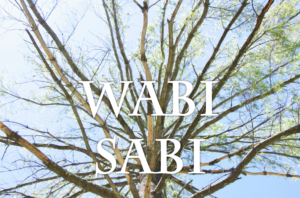
All the pictures used in this document were taken by the author.
I. Analysis of the photographs:
I have organized these photographs in three categories. First, two photos that I took this winter and selected because they fit in the wabi sabi aesthetic surprisingly well despite the fact that I took them before having this creative project assigned. Then, there is a set of photographs called “A night outdoors” that will be immersing the viewer in the atmosphere of an outdoor party/walk with friends on the Wesleyan campus. This set is characterized by spontaneity as I was taking photos in the midst of the action without any staging. Finally, the last set of photographs showcases one person, whom I have staged in each photograph. A few were taken indoors but most are, as in the previous sets, outdoors. None of the photographs were photoshopped, however some were reframed and color correction was used in some cases.
First Set: Winter is Taking Over
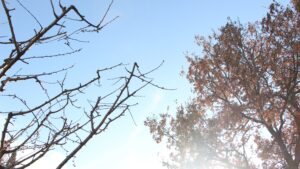
I took this photo at the beginning of winter last year (2020) while trying to do “nature photography”. Actually, nature happens to play an important role in the philosophy of wabi sabi as it perfectly showcases the raw beauty of things that are left untouched by human beings. The cyclical aspect of nature with the passing of seasons fits within the view Zen Buddhism has on life as an unending circle in which nothing lasts. In this photograph, the nude branches on the left seem to be attacking the ones on the right, still bearing the reddish leaves of autumn. Therefore, I think it is a rather simplistic but good representation of the passing of seasons, and by extension time. As we will see in many of the following photographs, the passing of time is an essential component of wabi sabi as it highlights impermanence.
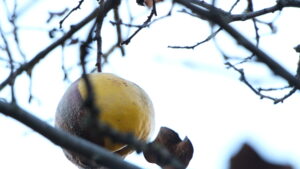
I was quite surprised by this half-yellow half-brown quince still hanging on a branch when I saw it. One side of this fruit looks like it could still be eaten while the other one is completely rotten. One may find wabi sabi in the imperfection of this quince and its signs of aging, but I must stress that the emphasis is not on disgust from the rotting, rather it is on the melancholy triggered by the realization that good fruits cannot be forever enjoyed. In addition, a follower of wabi sabi might argue that, in terms of pure visual aesthetics, such a fruit is more compelling to look at than a perfectly round and entirely yellow one. Indeed, uniqueness from imperfection is a trait valued in wabi sabi as shown by the diverse looks of Raku ware in chanoyu.
Second Set: A Night Outdoors



In contrast with the previous set, this one is more characterized by wabi sabi in terms of style rather than content. These three photographs all feature the same character. The use of a wide-angle lens and the low angle make him seem more imposing. The fact that we can only see his back or side profile adds to his mysterious aspect. As anyone who has ever tried to before knows, taking photographs at night is challenging because the light does not come in as well as in daylight, thus forcing the photographer to use higher ISO (in order to make the camera’s sensor more sensitive to light) and consequently reducing the quality of the image. However, I was not interested in having a clean, high quality image. Rather, this low quality had a certain advantage since it gave the photographs a more unique atmosphere. Like Japanese tea practitioners started to express admiration for what would have been considered flaws in earlier times, I expressed interest in what others usually consider to be a technical flaw.
In regards to the character featured, see how he has his hands in his pockets and is always slightly bent, looking at the ground. Although I did not direct him to do so (nothing was staged in this set), this attitude and the wide lens (increasing space in the frame) convey an impression of solitude, especially in the second photograph. Actually, despite being untranslatable, the term wabi implies a kind of loneliness.

How could I take wabi sabi photographs on the Wesleyan campus without doing one of these wooden bulletin boards riddled with old staples? The numerous staples still stuck in the wood give us a hint on the number of events this bulletin has helped to publicize. It is a good visual representation of time passing by as old posters are ripped out and new posters stapled on their residues. Indeed, wabi sabi is much more interested in such bulletin boards that show signs of wearing, rather than brand new ones, which do not have any noticeable characteristic. One might wonder what happened to the “Welcome Back Wesleyan Students!” poster. In addition, these torn posters, and their scarcity, give a sense of desolation, which is not uncommon in the Wesleyan campus life during pandemic, and in accordance with the meaning of wabi.


As you may have noticed by now, some of these photographs seem a bit blurry, one reason for that is that we were on the move and I took the pictures while walking. Still, I purposefully chose to do so because, as with the ISO that I mentioned earlier, this blurriness adds a certain quality to the image. If the first photograph were in perfect focus, we would not have the impression that the characters are walking/moving but simply standing still (as in the second photograph). In other words, this blurriness is my attempt to visually represent the passing of time. Indeed, movement cannot be perfectly captured by a single photograph (unlike film, but film is only an illusion since it is 24 frames per second). Whenever people are standing still in a photo, or the focus is perfect, it gives the illusion to the viewer that this moment is timeless. In that sense, conventional photography is somehow antithetical to wabi sabi as this philosophy is deeply rooted in the Zen Buddhist acknowledgement that nothing is permanent.

I took the second photograph in a very dark environment, therefore the candles were the only source of light on which I could rely to see my subjects. In comparison with professional or staged photography, this is a very minimal lightning. Consequently, we do not see the characters perfectly but the feeble lightning provided by the candles give a sense of intimacy and modesty, which are among the core principles of wabi sabi. Indeed, I used a single, ancient (candles), source of light to photograph my subjects in the same way that chanoyu masters during tea ceremony use economical movements, with as little extravagance as possible, to pour the tea.
I find that this photograph combines quite well the three wabi sabi principles covered in this set: solitude, blurriness that translates the fleeting nature of the moment, and minimal lightning.
Third Set: Staged Wabi Sabi


It is clear that those photographs are the idea of blurriness (low shutter speed) showing the passing of time pushed to the extreme. I find the first photograph interesting because the picture almost becomes abstract (I simply quickly moved the camera while taking the photo). Here, the seemingly technological flaw of low shutter speed is too exaggerated to be a flaw and becomes an artistic tool. We can barely distinguish the facial features of the character, almost in the same way our memory fails us when we try to remember someone’s face. And memory gets worse and worse with time, consequently, the features fade away. In that sense, I wanted to convey the consequences time has on our relationship to things, people, thus justifying Zen Buddhism’s concern on impermanence and the suffering caused by being attached to people despite their inevitable disappearance. This aspect of Zen Buddhism also found its way in wabi sabi.
The second picture might remind the viewer of some time-lapse videos where people are walking by very fast (blurried) but the structures stay the same (in focus), unchanged. Indeed, time has an impact on everything, but it affects some more than others: while human beings come and go on this earth rather quickly, some objects stay longer. Eiffel has been dead a long time but the Eiffel Tower is still standing.

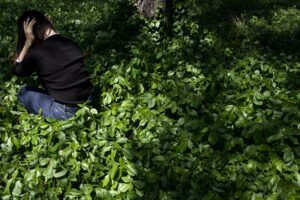
If you have watched Mizoguchi Kenji, Ozu Yasujiro or Kore-eda Hirokazu’s films, you have probably noticed that, unlike their Hollywood counterparts, they usually do not directly display emotion on screen. Actually, these directors prefer to imply emotion or convey it indirectly. Part of this stylistic preference comes from the philosophy of wabi sabi. Indeed, since this aesthetic promotes austerity and simplicity, excess of emotion seems unfitting. Hence, to convey the emotions of my character, I had her turn her back to the camera. From this staging results an emotional modesty, which for example in the first photograph highlights melancholy instead of sadness. In the end, what she feels are up to the viewer’s interpretation but the lightning, and her facing the wall instead of the window suggest negative emotions. The restraint on emotions also emphasizes inwardness instead of outside expression. In accordance with Zen Buddhism, the character in the photographs seems to be focusing on themselves, on their inward emotions, rather than on displaying them to us.
Best represented in the second photograph, this focus on oneself goes along loneliness in nature (wabi), which fosters ideal meditation according to Zen Buddhist wabi practitioners. The framing is unusual because she is situated on the upper left part of the frame, going against conventional framing rules such as the rule of thirds. In fact, asymmetry is often found in wabi sabi because it is a way to show that one does not pretend to perfection, as it cannot be reached in our impermanent world, therefore can only lead to suffering.
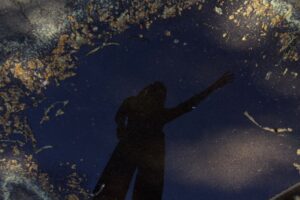


Still within the theme of loneliness in nature, the first photograph showcases the reflection of the character in the water, who is nothing more than a shadow at that point, preventing the viewer from seeing any of her emotions. The dirty water is like a second screen through which we see a minimalistic representation of the character, the wabi sabi filter. Indeed, the dirtiness could give cues to the viewer on the character’s mood. What was originally a dirty little pond of water in the middle of the courtyard became an original way to reframe the character like using rustic utensils and more natural frameworks are preferred to extravagant settings in wabi tea ceremonies. Wabi sabi is about giving the spotlight to what would have otherwise been deemed ugly or not worth the attention.
I took the second photograph while looking for a way to portray simplicity without being dull. The framing is emphasizing emptiness, making the viewer wonder what is missing. In addition, the wall looks a little weary and the ground is dirty. These characteristics make the picture look austere and desolate, which are characteristics of wabi sabi. After all, this aesthetic emerged with Zen Buddhism, a religion emphasizing meditation, which needs austerity so that one can focus on the inner self, and nothingness, which is the ideal state (Nirvana) monks aspire to.
The intent of the third photograph might actually be one of the most explicit. Here, I used the wabi sabi principles of asymmetry, emptiness, and emotional restrain discussed in the previous photographs to convey the solitude caused by social distancing during the pandemic.


These two last photographs feature hands, but in the first one it is the table I am the most interested in. Although it is not clear in the final result, I asked my model to place her nails on one of the messages carved in the wood as if the character fell asleep (or died?) while writing messages on the table. I should have actually given her a tool because carving in wood with nails does not sound very realistic. In any case, the table alone tells a story. Indeed, wabi sabi lends itself quite well to those kinds of items full of carvings that showcase the stories they have witnessed. Like the bulletin boards, not only do these messages show the passing of time but they also make this table unique as opposed to a smooth and clean new one.
Finally, the last photograph showcases what one might find unpleasant at first glance but actually has a certain beauty. Akin to wrinkles of old age, there is a wabi sabi aesthetic to the patterns traced on this hand. They appeared because of a prolonged contact with the grass, thus, like wrinkles, they are signs of the passing of time and the effects of nature on the human body. The grass patterns on the hand are like the cracks in the ware of chanoyu tea, imperfect yet beautiful as per their genuineness.
II. What is Wabi Sabi?
To me, this aesthetic philosophy has always been very important. However, I did not always know it as wabi sabi. Actually, when I first learned about wabi sabi several years ago, I felt that words were put on what I had been thinking about for a long time: the fact that imperfection is sometimes more compelling than alleged perfection, or that raw, more natural materials (or even food), are preferable to the products of our industrialized societies. There has been, in developed western countries too, a desire for authenticity, a desire to escape from the oppressing society of perfection brought by modernity. Even when wabi sabi emerged in the 14th century, as Professor Takeshi Watanabe wrote in the chapter “Breaking Down Boundaries: A History of Chanoyu”, using unpretentious utensils in wabi tea ceremonies served as an “antidote to the engulfing richness of the new consumer society”. Increasing wealth might cause us to lose touch with the real world, and this aesthetic philosophy is there to bring us back to what is essential. In cinema, the medium I am the most familiar with, I had encountered some form of wabi sabi-like aesthetics even before getting interested in Japanese filmmakers. The Dogme95 movement for example, initiated by Lars Von Trier and Thomas Vinterberg, was meant to be an aesthetic opposition to Hollywood’s polished films and valued spontaneity over carefully planned framing and staging. To me, wabi sabi was initially a reaction to specific aesthetic ideals rather than an aesthetic of its own.
This conception of wabi sabi can be explained by the fact that, not only the Western world, but Japan too has been marketing this philosophy as “the beauty of imperfection”. According to this definition, in order to know what wabi sabi, is one has to know what perfection is. However, in aesthetics especially, what is valued as perfect often varies from culture to culture. Consequently, wabi sabi could take any form and is often practiced in a context far removed from what it was originally intended to be. Mary Elizabeth Berry even writes that wabi tea was “less a consistent aesthetic than an unending search for variety and surprise,” and “an art of invention and reinvention” (Watanabe). This shows that from the very beginning, wabi sabi was never really clearly defined and could be adapted to anything. When marketing the ideal “beauty of imperfection”, I suspect that Japan, and the West, both refer to perfection as western-influenced ideals (in the 14th century it was Chinese ware). In that sense, as Professor Watanabe pointed out in the CEAS207 2021 class forum on the taste of umami, wabi sabi is a way to resist the West (and was a way to resist China?) and emphasize the cultural distinctiveness of Japan. To have a grasp of what wabi sabi is really about, one must view it in the context of Zen Buddhism where it was introduced by the monk Murata Shuko. Imperfections are actually the effects of nature, or time, thus showing that the world escapes man’s control. In addition, a theme that is sometimes neglected when talking about wabi sabi is loneliness, and one’s quiet relationship with nature; hence the absence of extravagance in wabi sabi works.
Still, this philosophy remains quite vague and, consequently, I have often questioned the wabi sabi quality of my photographs. For example, when we look at Shuko’s original intent and the qualities that are considered wabi sabi nowadays, we can find some contradictions. Shuko initially simplified the setting of the tea ceremony to transform it in a mystical space that would transcend time and place. Indeed, he wanted to blur the line between both Chinese and Japanese cultures, getting rid of distinctive features. Yet, wabi sabi finds beauty in the uniqueness of an object such as a bowl with cracks. Therefore, the simplicity and imperfection wabi sabi values can contradict themselves. While taking pictures, looking for imperfection while trying not to be dramatic is a fine line to walk. Furthermore, wabi sabi is about what escapes our control; so it is ironic that human beings who want to achieve this aesthetic sometimes wittingly produce imperfections. The form is there but the essence is not. That is how I think about my photographs, especially regarding the staged set. Still, if imperfections should not be voluntary, it would mean that only the works of those who are less experienced in the practice of the given art would be worthy of wabi sabi. Thus, this reasoning explains the emergence of wabi sabi as being in part “a practical accommodation to new circumstances” (Watanabe) when wars were destroying old collections. Then, wabi sabi should maybe be more of a state of mind (similar to Zen Buddhism) audiences must adopt in order to appreciate certain things rather than an aesthetic artists actively seek to practice…
WORK CITED
Watanabe, Takeshi. “Breaking Down Boundaries: A History of Chanoyu.” Tea Culture of Japan, by Sadako Ohki. Yale University Art Gallery. 2009. A&AePortal, www.aaeportal.com/?id=-18219.
